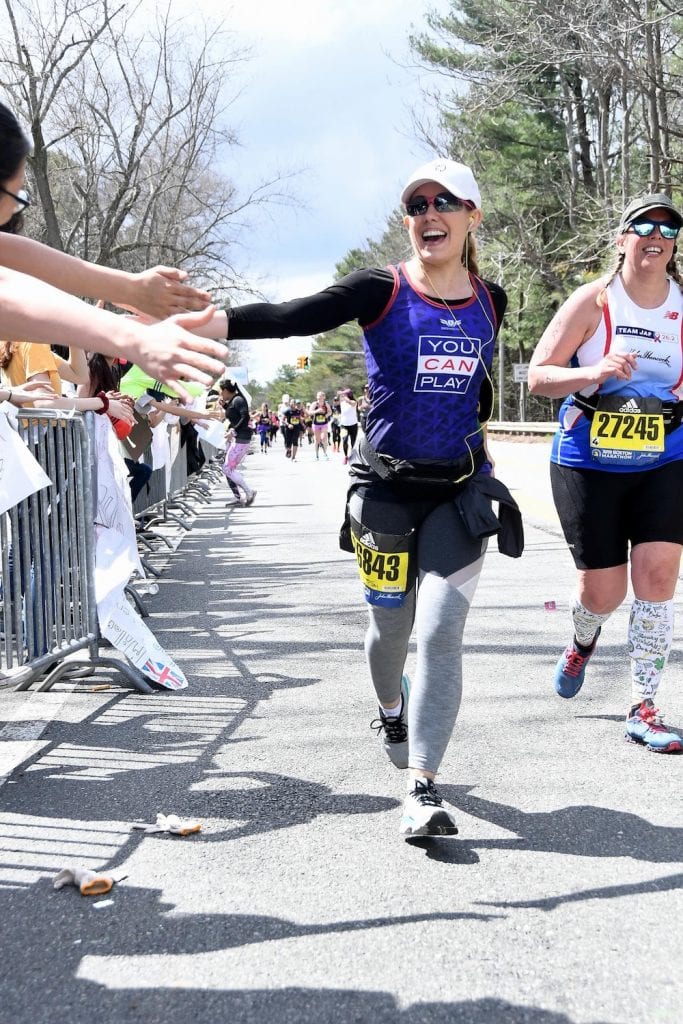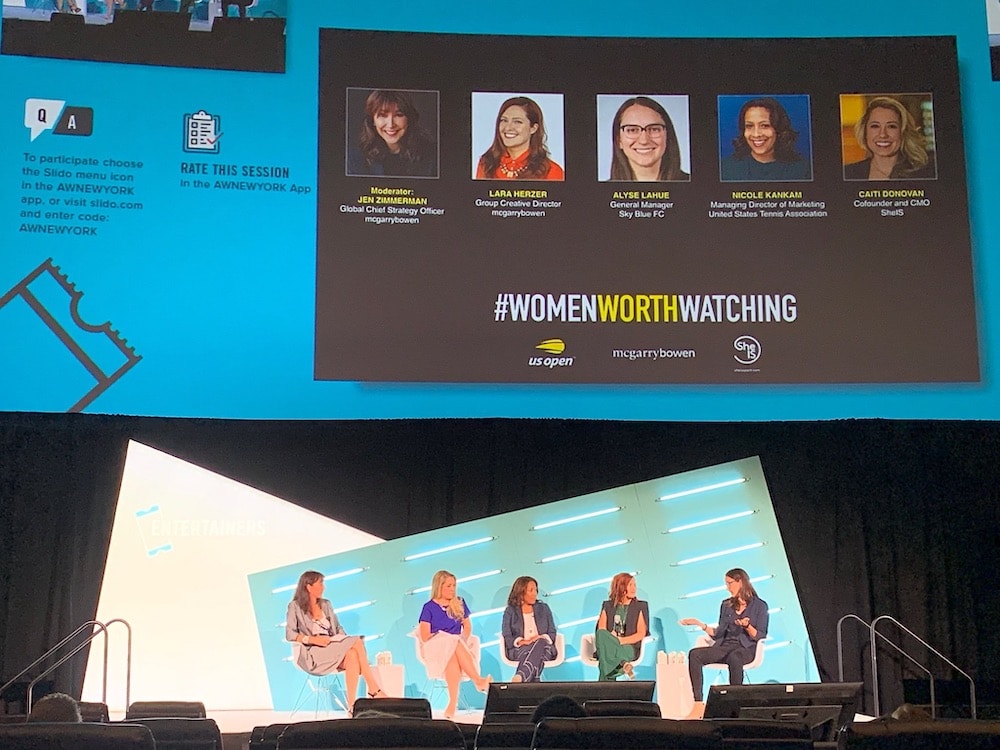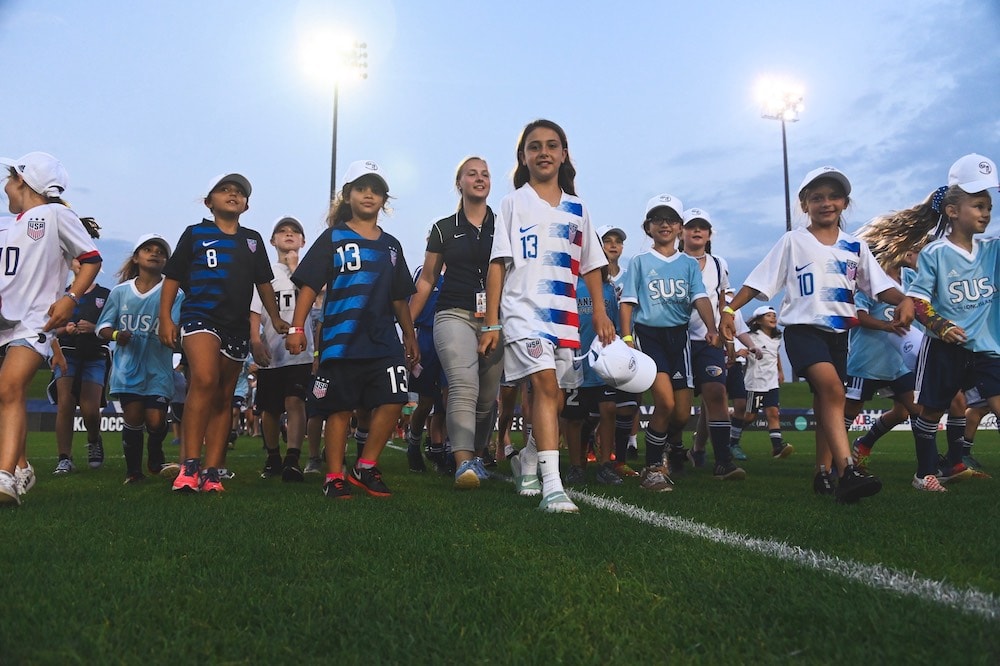Mappy Hour ’20 Speaker
Athletes are working hard on the pitch or the pitch (get it?) to bring gender equality into the world of sports and outdoors. Behind the scenes, a squad of professionals work just as hard to make sure that these sports are accessible to the fans. Entrepreneur and sports enthusiast, Caiti Donovan is currently working on bringing women’s sports closer to the fans through her organization, SheIS. Mappy Hour sat down with her and chatted about how far both she and women’s sports have come, and how much farther they need to go.
How did you first get immersed in sports?
I have been an athlete basically my entire life, I played five different sports growing up and now I am a marathon runner. In addition, I’ve always been a huge sports fan. On any given weekend you’ll probably find me watching anywhere between three and five sporting events. So I’ve always been immersed in what it means from a broader society perspective, and what it’s meant for me personally as an athlete.

What are some of your favorite outdoor places in or near NYC?
Central Park is one of my favorite places to go running, and the environment that has been created there is really wonderful. We live on the Upper East Side, so we’re a five-minute walk away from the park and from the Jackie Onassis Reservoir. I’ve done most of my marathon training over the years in that park, which means that it holds a special, both love and hate (laughs) relationship with me, because as you’re doing your fourth lap, you just get a little bit monotonous. But it’s also a form of affection because it’s a place that has enabled me to compete in marathons.
If we go slightly further outside of the city, I am also a huge fan of the Palisades Interstate Park. The views are really incredible, once you get up to the top you’re straddling both the New York and New Jersey border, and you have these sweeping views of the Hudson Valley. It can be an easy or difficult hike, but it’s generally something that’s always been a really fun experience.
Can you tell me a bit about your organization?
My business, called SheIS Sport, is a non-profit organization formed with the mission of connecting with and mobilizing fans to grow women’s sports. We do that in three primary ways:
One is around increasing the attendance and viewership of women’s sports, getting people to actually watch. Obviously right now it’s a difficult thing to achieve (because of the COVID-19 pandemic), and we’re in a state of flux, but that hasn’t decreased our focus on our other two pillars, which are around storytelling and centralizing resources. We really try to look at how we can centralize information and resources and we do this in a couple of different ways: one is to centralize for the “SheIS” collective itself, asking “how do we ensure we are helping to build stronger structural opportunities within women’s sports”?
“How do we ensure we are helping to build stronger structural opportunities within women’s sports”?
And how can we create opportunities for fans to engage? For example we are currently in the process of working on digital watch parties, and creating a model and a way for fans to watch a variety of different women’s sports that are being streamed.
Now that your organization is nationwide, how are you working to improve representation of women in sports? Who are you working with?
Broadly speaking, our objective is, again, to connect fans, but probably more importantly, to mobilize them. So when we look at representation within the sports community, we make sure that women and girls have the right representation, the right opportunity to see the sports world as something that they can be a part of. We look at different opportunities to connect them with various athletes, with different role models who exist already in this space. One of the ways that we’ve done that in the past is through our “Women Worth Watching” campaign, last year we launched a partnership with the USTA around the US Open, and in a six week period, we had 4.6 million engagements online. The premise of the campaign was that only four percent of sports media currently focuses on women’s sports, but we believe that the fans can be the difference maker here. By sharing the hashtag #womenworthwatching, fans can share their own stories about women in sports, that they believe are worth watching and sharing. That type of visibility creates a new normal for the next generation.

After recent sports events, like the US Women’s Soccer National Team and the SheBelieves Cup, do you think the position of women in sport has improved, and what else needs to happen?
Women’s sports were, and absolutely very much are, hitting an incredible turning point. Over the past 18 to 24 months, we’ve seen a dynamic shift in society. Part of this was due to things like the 2018 US Women’s hockey team winning the Gold Cup for the first time in twenty years. That was directly followed by 2019 when the USWNT won the World Cup, the first time any country has done a back-to-back win (in the Women’s World Cup; in the World Cup, the title has been defended twice by Italy and Brazil, albeit almost six decades ago). Now, although it’s been postponed, we are coming into 2020 with the expectation of the Olympics, which has always been a very heightened moment for women to really shine, and has always created a mass appeal and support for women in sport. We’ve seen a number of key moments in the past couple of years, paired with a change and shifting societal mentality around women’s participation in sports. Since Title 9 was passed, there’s been a 622% increase in women and girl’s participation in sport on all levels and across the board. This means that you have a strong pipeline coming into the professional level of sport. You start to feel a lot of incredible talent coming in, and now you have standout stars (i.e. Alex Morgan, Sue Bird, etc.). Now when you look at the past two years alone, there are a multitude of events that are happening consecutively, so you’re starting to see this real progression and shift on how people view women in sport, and they come out in droves. That SheBelieves Cup game that I was at, there were more than 26000 people there. so there’s something to be said for the fanbase and the real shift that’s been happening.

What do you think the future holds for women in sports? Who / What organizations are leading the charge?
There’s a lot of unknown right now for sure, but I think we’ve hit a moment in time that shifts have occurred. We’re seeing more people support women in general across society, we’re seeing more people idolize these women in sport, and it’s not just women supporting women, it’s young boys dressing up as Megan Rapinoe for Halloween, it’s men and decision makers sitting in rooms together and saying “yes, of course, we’re going to support women’s sports, we’re going to invest in that” so there is that shift coming, and I see that coming in the future as well.

What can we do to raise awareness for representation for women in sports?
There are two big ways: one is language, and the other is taking action.
Your language matters, what you say matters.
If you use the phrase “he’s playing like a girl,” even though it’s meant as a joke, those are subtle cues that get picked up. What we need to start understanding as a broader society both in and out of the sports world is that first and foremost, a woman or a girl’s proximity to compete with a man or a boy does not ultimately determine her worth. By putting that into more certain terms and telling a girl that she needs to play with and beat the boys in order to be considered a basketball player is a subtle cue that women and girls are not as good at sports. We’re placing a very gendered identity in a space that will only end up constricting its future potential. So changing, shifting that language is one of the first things that we at a community level can do, just be conscious of your language. Just give that young girl space to be worthy in her own right.
The second part to that is taking action. Changing your language is a form of taking action. But it also means that if you say “I support women and girls being in sport, playing sports, being coaching,” actually take action behind that. Put your money where your mouth is, buy tickets, make sure that you’re going to watch women’s sports, pay for the season passes. In a lot of cases the average cost to be able to go to a football game is hundreds of dollars per ticket. With women’s sports, you have a much more accessible entry point, and it’s not because the quality of the product isn’t there. What we need to start doing is appreciate it for what it is, for its own sport, and allowing for that to be the entry point. So taking that action, making a conscious choice to say “if I’m going to spend money on a jersey, if I’m going to support a non-profit or a cause, I’m going to make sure I take an active stance and make sure that I am equally supporting things that will help improve women in sport, as much as I might otherwise support the sports industry.

